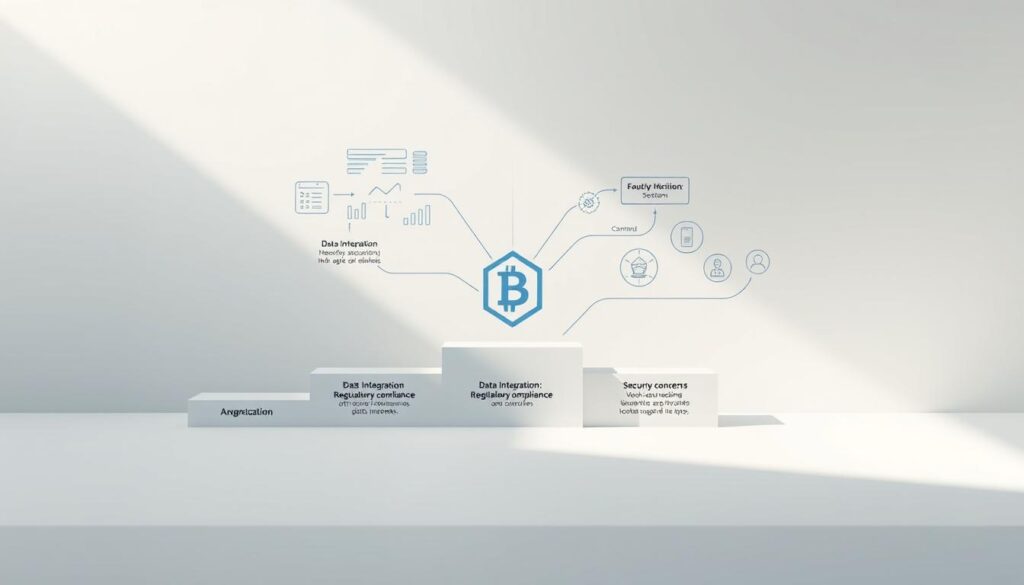Now Reading: The Role of Blockchain in Insurance Claims Processing Automation
- 01
The Role of Blockchain in Insurance Claims Processing Automation
The Role of Blockchain in Insurance Claims Processing Automation

The modern insurance sector faces significant hurdles. Cumbersome paperwork, slow settlements, and lost information plague complex processes. These inefficiencies create frustration for everyone involved.
A major concern is fraud, which costs over $40 billion annually in the United States. This financial drain impacts premiums and company stability. Perhaps more damaging is a widespread trust deficit. A recent global survey revealed that 42% of customers lack full confidence in their providers.
Emerging digital solutions offer a path forward. Blockchain technology introduces a paradigm shift through its decentralized and transparent nature. This approach automates workflows and builds verifiable trust between all parties.
The momentum behind this innovation is substantial. The global market for this technology in the insurance industry was valued at nearly $25 billion in 2024. This investment signals a strong belief in its potential to solve core challenges.
For insurers, this means streamlining operations from underwriting to settlements. It provides a secure way to manage sensitive data and reduce fraudulent claims. While adoption is still growing, practical applications are already delivering measurable results.
Key Takeaways
- The insurance sector struggles with slow processes, high fraud costs, and customer distrust.
- Blockchain introduces a decentralized system that enhances transparency and security.
- This technology can automate complex workflows, speeding up settlements.
- It helps build trust by creating an immutable record of all transactions.
- The global market value shows significant industry investment and belief in its potential.
- Early applications are proving effective in streamlining operations and preventing fraud.
Understanding Blockchain Technology in the Insurance Sector
The foundation of this innovative approach lies in a decentralized system that eliminates single points of failure. This creates a shared database where all participants have equal access to the same information.
What is Blockchain and How It Works
At its core, this technology functions as a distributed ledger. Multiple computers maintain identical copies of all records. When a new transaction occurs, the network must reach agreement before adding it.
This consensus mechanism ensures that no single entity controls the process. Each participant validates changes through cryptographic protocols. Once verified, the data becomes permanent and cannot be altered.
The Evolution of Blockchain in Insurance
The adoption of this technology within the insurance sector has grown steadily. Early pilots demonstrated its potential for creating blockchain-powered insurance models. These systems provide complete transparency throughout the entire process.
Major carriers now implement distributed ledger solutions to streamline operations. The immutable nature of these records builds trust between all parties. This evolution represents a significant shift toward more efficient digital systems.
Exploring the Benefits of Blockchain for Insurance Claims Processing
The implementation of decentralized record-keeping brings measurable improvements to carrier operations. This technology delivers concrete advantages that address longstanding industry challenges.

Enhanced Security and Fraud Prevention
Distributed ledger systems provide exceptional protection against fraudulent activities. Allianz reported a 25% reduction in dishonest submissions during 2023 using this approach.
Industry-wide implementations prevent 65% of application fraud. The cryptographic verification process makes manipulation extremely difficult. Multiple network nodes validate each transaction.
| Traditional Approach | Blockchain Solution | Improvement |
|---|---|---|
| Centralized databases | Distributed ledger | Eliminates single points of failure |
| Manual verification | Automated consensus | 80% reduction in duplicate claims |
| Delayed fraud detection | Real-time monitoring | $87 million annual savings |
Improved Data Integrity and Transparency
This technology maintains complete submission history that prevents false or repeated filings. The immutable nature ensures information cannot be altered after recording.
All stakeholders can view and verify transactions through the shared ledger. This builds trust between carriers and policyholders. The system creates permanent, tamper-proof records.
These blockchain insurance benefits extend beyond security to operational efficiency. Carriers gain better insights into customer risk profiles while reducing administrative costs.
Implementing “blockchain in insurance claims processing automation” for Better Claims Workflow
Real-world implementations show dramatic improvements in settlement speed and accuracy. These systems use self-executing agreements to handle submissions automatically.

Leveraging Smart Contracts for Automation
Smart contracts are digital agreements that execute automatically when conditions are met. AXA’s Fizzy system for flight delays demonstrates this power. It achieved 90% cost reduction and 100% payout accuracy.
These contracts have terms written directly into code. They verify and approve submissions without human intervention. This eliminates intermediaries and manual steps.
Lemonade’s parametric coverage for Kenyan farmers shows another application. It uses IoT weather data for 100% automated processing. Farmers receive payouts within 24 hours of drought detection.
Strategies for Real-Time Claim Settlements
Modern systems achieve remarkable speed improvements. Crop coverage processing dropped from 3 months to 3 days. Automated validation reaches 92% accuracy with 45-second payouts.
The B3i platform enables 60% faster contract execution. This allows multiple carriers to share risks efficiently. All parties can monitor progress through each stage.
These approaches create transparent, trustless marketplaces. Buyers and sellers agree on terms enforced by the technology. The result is instant settlements when predetermined conditions occur.
Overcoming Challenges and Creating a Roadmap for Integration
Scalability and compatibility with old systems are primary concerns for large organizations. These firms process millions of transactions daily. Current digital ledger networks can struggle with this volume.
Integrating new platforms with decades-old core software is complex. These legacy systems handle critical policy and billing functions. A seamless connection is essential for success.

Addressing Scalability and Legacy System Limitations
Regulatory uncertainty adds another layer of difficulty. The sector is highly regulated with strict compliance rules. These must be addressed within any new network implementation.
An IBM survey found that over 75% of executives see this technology disrupting the traditional value chain. This creates urgency for established players to adapt.
Newer, smaller companies are leveraging this tech to redefine customer experience. They combine it with AI and IoT for innovative products. Incumbents must use their deep industry knowledge and customer access to compete.
Strategies exist to overcome these hurdles. Consortium approaches, where multiple firms share a network, distribute costs and improve throughput.
Decentralized identity solutions enhance security. They store private customer data locally. The shared ledger then provides a secure framework for exchange, reducing breach risks.
| Implementation Challenge | Strategic Response | Key Benefit |
|---|---|---|
| Network Scalability Limits | Industry Consortiums | Shared infrastructure cost; higher transaction capacity |
| Legacy System Integration | Phased Implementation | Start with specific use cases like fraud detection |
| Regulatory Compliance | Decentralized Identity | Meets KYC/AML rules while protecting user information |
The roadmap involves a phased approach. Begin with targeted applications before expanding. As the technology matures, integration with AI and IoT will unlock even greater potential for risk assessment and personalized offerings.
Companies that successfully shift to platform models can achieve significantly higher valuations. They reach more customers and join valuable partner ecosystems.
Conclusion
Distributed network solutions are reshaping how protection providers handle customer interactions. This blockchain technology creates a foundation for unprecedented operational excellence throughout the insurance industry.
The measurable benefits are substantial. Companies see fraud reduction up to 80% and cost savings reaching 90%. Settlement times drop from months to minutes. These improvements build essential trust between all parties.
Real-time data accessibility transforms risk assessment and claims resolution. While implementation requires careful planning, the competitive advantages make this investment crucial. The entire industry moves toward a more efficient, customer-focused future.
FAQ
How does distributed ledger technology enhance security for the industry?
This technology creates an unchangeable, shared record of transactions. Every entry is encrypted and linked to the previous one, making unauthorized alterations nearly impossible. This significantly reduces risk and builds greater trust among all parties involved.
What are smart contracts and how do they automate the process?
Smart contracts are self-executing agreements with terms written directly into code. When predefined conditions are met, like a verified damage report, the contract automatically triggers actions, such as issuing a payment. This cuts down on manual work and speeds up settlements.
Can this system help lower operational costs for companies?
A> Yes, by automating manual tasks and reducing the need for intermediaries, organizations can achieve significant savings. The efficiency gains from a streamlined workflow and decreased fraud directly translate to lower administrative expenses.
What is the potential for preventing fraud with this approach?
The transparency and permanence of the ledger make it extremely difficult to submit false information. Since every step in a claim’s history is visible and tamper-proof, it becomes much easier to detect and prevent suspicious activities, protecting both the customer and the firm.
What are the main hurdles for insurers adopting this new technology?
Key challenges include integrating with existing legacy systems, ensuring regulatory compliance, and managing the initial investment. Scalability and achieving industry-wide collaboration for a shared network are also significant considerations for a successful rollout.















